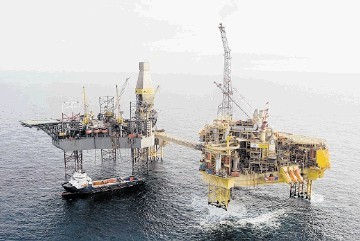
Work can begin to try to stem the gas spewing out of Total’s stricken Elgin platform in a matter of days.
The French energy giant announced last night that final preparations for the planned intervention on the Elgin’s G4 well are nearing completion and that work was due to start within the next few days.
This week, the West Phoenix drilling rig has been put in position just under 100ft away from the leaking platform ready to support the operation.
Before moving alongside the Elgin, the West Phoenix had been on standby getting ready.
Bosses at Total also said yesterday that the rate of gas leaking from the platform is “diminishing significantly”.
Two weeks ago, a specially-made “diverter” had been fitted to the G4 wellhead and is now carrying the leaking gas away from the platform.
The device carries the gas through four hoses and ensures there are no hydrocarbons accumulating around G4.
As before, the gas will continue to leak into the atmosphere and some condensates will also go into sea as the diverter only affects the direction of leaking gas, not the volume.
However, the estimated flow-rate is now believed to be less than a third of what it was in the initial stages of the leak.
It is now predicted that just less than 2.5 tonnes of gas are escaping from the G4 well every hour, compared with the seven tonnes which started leaking on March 25.
All 238 men had to be evacuated from the platform more than a month ago, after the leak was discovered.
Since then, plans have been put in motion to develop two technical solutions to stem the gas.
The first approach will involve heavy mud being pumped down into the well from the top at high pressure using the West Phoenix, a semi-submersible platform.
Once the mud has blocked the gas and restored the normal pressure, cement will be poured into the well to seal it.
Drilling of the first back-up relief well by the Sedco 714 is still progressing as planned.